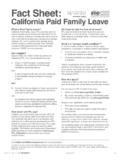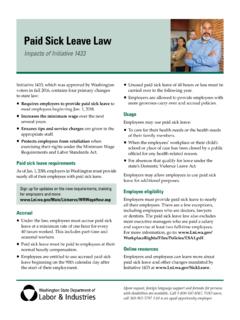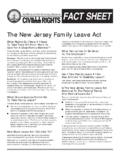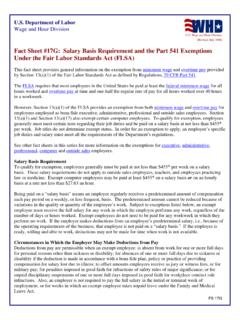Transcription of Fact Sheet Family Unification Vouchers Jan 2017
1 fact Sheet HOUSING CHOICE VOUCHER PROGRAM Family Unification Program (FUP) Office of Housing Voucher Programs **January 2017** What is FUP? FUP is a program under which Housing Choice Vouchers (HCVs) are provided to: Families for whom the lack of adequate housing is a primary factor in either: oThe imminent placement of the Family s child or children in out-of-home care. oThe delay in the discharge of the child or children to the Family from out-of-home care. There is no time limitation on FUP Family Vouchers . Youth at least 18 years old and not more than 24 years old who: Left foster care at age 16 or older or will leave foster care within 90 days, in accordance with a transition plan described in section 475(5)(H) of the Social Security Act; and Are homeless; or Are at risk of homelessness.
2 FUP Vouchers used by youth are limited, by statute, to 36 months of housing assistance. Families and youth may use the Vouchers provided through FUP to lease decent, safe, and sanitary housing in the private housing market. How does the program work?Public housing agencies (PHAs) administer FUP in partnership with Public Child Welfare Agencies (PCWAs). The PCWA initially determines if the Family or youth meets the FUP eligibility requirements, certifies that the Family or youth is eligible, and refers those families or youths to the PHA. Once the PCWA makes the referral, the PHA places the FUP applicant on its HCV waiting list and determines whether the Family or youth meets HCV program eligibility requirements, including income eligibility.
3 The PHA conducts all other processes relating to voucher issuance and administration. In addition to rental assistance, supportive services must be provided to FUP youths by the PCWA for the first 18 months that the youth participates in the program. Examples of the skills targeted by these services include money management skills, job preparation, educational counseling, and proper nutrition and meal preparation. The program does not require PCWAs to provide supportive services for families; however, PCWAs may make them available to families as well. While the FUP program is administered in accordance with HCV program regulations, the FUP Notice of Funding Availability (NOFA) issued by HUD provides specific program information and requirements such as the targeted population, the Memorandum of Understanding (MOU) by which PHAs and PCWAs establish their partnership, and rating criteria for review and selection of applications, among others.
4 Who is eligible? To be eligible, applicants must meet specific FUP eligibility requirements as well as HCV eligibility requirements. FUP Eligibility Requirements The PCWA must certify that the Family or youth meets specific program requirements. For families, the PCWA will certify that this is a Family for whom the lack of adequate housing is a primary factor in either the: Imminent placement of the Family 's child or children in out-of-home care, or Delay of discharge of a child or children to the Family from out-of-home care. A Family meets the definition of lack of adequate housing if a Family or youth is: Living in substandard or dilapidated housing. Homeless. In imminent danger of losing their home.
5 Displaced by domestic violence. Living in an overcrowded unit. Living in housing not accessible to the Family s disabled child or children, or to the youth due to the nature of the disability. For additional details, please see the most recent FUP NOFA (2010). For youth, the PCWA will certify that the youth is at least 18 years old and not more than 24 years old (has not reached his/her 25th birthday), that he/she left foster care at age 16 or older or will leave foster care within 90 days, in accordance with a transition plan, and is homeless or at risk of homelessness. A youth meets the definition of at risk of homelessness if the youth: (i) Has an annual income below 30 percent of median household income for the area, as determined by HUD; (ii) Does not have sufficient resources or support networks, , Family , friends, faith-based or other social networks, immediately available to prevent them from moving to an emergency shelter or another place described in paragraph (1) of the homeless definition in this section; and (iii) Meets one of the following conditions: (A) Has moved because of economic reasons two or more times during the 60 days immediately preceding the application for homelessness prevention assistance.
6 (B) Is living in the home of another because of economic hardship; (C) Has been notified in writing that their right to occupy their current housing or living situation will be terminated within 21 days after the date of application for assistance; (D) Lives in a hotel or motel and the cost of the hotel or motel stay is not paid by charitable organizations or by Federal, State, or local government programs for low-income individuals; (E) Lives in a single-room occupancy or efficiency apartment unit in which there reside more than two persons or lives in a larger housing unit in which there reside more than persons reside per room, as defined by the Census Bureau; (F) Is exiting a publicly funded institution, or system of care (such as a health-care facility, a mental health facility, foster care or other youth facility, or correction program or institution); or (G) Otherwise lives in housing that has characteristics associated with instability and an increased risk of homelessness; A youth may also be at risk of homelessness if the youth meets the definition of homeless under a number of other federal programs.
7 For more information, please see 24 CFR HCV Eligibility Requirements After the PCWA certifies and refers the Family or youth to the PHA, the PHA then determines whether the Family or youth meets HCV program eligibility requirements, including income eligibility. Once the PHA determines that the Family or youth meets HCV eligibility requirements the Family or youth may be issued a voucher. Income eligibility for a housing voucher is determined by the PHA based on the total annual gross income and Family size compared with the HUD-established income limits for the area. In general, the Family 's or youth s income may not exceed 50 percent of the median income (very low-income limit) for the county or metropolitan area in which the Family or youth chooses to live.
8 By law, a PHA must provide 75 percent of its Vouchers to applicants whose incomes do not exceed 30 percent (extremely low-income limit) of the area median income. Median income levels are published by HUD and vary by location. How do I apply for FUP Vouchers ? Because FUP funding is allocated through a competitive process, not all PHAs administer the program. Individuals who are interested in obtaining a FUP voucher can access a list of FUP PHAs and PHA contact information on HUD s website. Once I have a FUP voucher, what do I do next? It is the responsibility of the Family or youth to find a unit that meets their needs. Once the Family or youth finds a suitable unit and the owner is willing to lease the unit under the program, the Family or youth must request tenancy approval from the PHA.
9 The Family or youth must submit a request for tenancy approval (RFTA) to the PHA no later than the expiration date stated on the voucher. If the PHA determines that the unit meets housing quality standards, that the rent is reasonable, and that the unit meets other program requirements, the PHA executes a Housing Assistance Payments (HAP) Contract with the property owner. This contract authorizes the PHA to make rent subsidy payments on behalf of the Family or youth. The Family or youth will then execute a lease with the owner. Where can I use my FUP voucher? A Family or youth may choose a unit anywhere in the United States where there is a PHA that administers the HCV program. However, new voucher holders not living in the jurisdiction of the PHA at the time the Family or youth applied for housing assistance may be required to lease a unit within that PHA s jurisdiction for the first 12 months of assistance.
10 Can I move from my unit with continued assistance? A Family or youth may move to a new unit with continued assistance if the lease for the old unit has been terminated (the PHA has terminated the HAP contract for the owner s breach or the lease is terminated by mutual agreement of owner and tenant); if the owner has given the tenant notice to vacate; or the tenant has given notice of lease termination in accordance with the lease, among others. If the Family or youth wants to move to a new unit, the Family or youth must notify the PHA and the owner before moving from the old unit, unless allowed under the Violence Against Women Act Final Rule. A Family or youth may move with continued assistance under the program either inside the PHA s jurisdiction or under portability procedures.
















